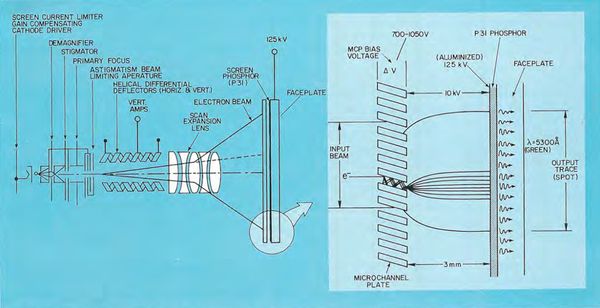Micro-channel plate CRT
The Micro-channel plate (MCP) is a form of secondary electron multiplier that can be included in a CRT to improve the brightness of the trace, which is needed particularly at high sweep rates. Typically it sits directly behind the face of the CRT. It requires its own bias voltage.

The electron beam passes through the deflection plates before it hits the micro-channel plate, which consists of parallel channels offset at a slight angle to the beam. The inside walls of these channels are coated with resistive material, with an acceleration voltage on the order of 1 kV applied between back and front of the plate.
Due to the offset angle, electrons entering a channel will hit its wall, where they initiate a cascade of secondary electron emission like in a photomultiplier. At the exit of the channels, a final acceleration voltage propels the beam across a small gap toward the CRT's phosphor coating. In a typical MCP CRT like the T7100, the channels have 25 μm diameters.
MCP amplification deteriorates in proportion to total charge passed per channel or unit of area, making them particularly prone to a form of burn-in. Careful biasing along with beam current/time limiting mechanisms are necessary to achieve the full life time.
The MCP enables an improved system bandwidth overall.
MCP tubes are used in the following Tektronix products:
Links
- Micro-channel plate detector @ Wikipedia
- Tektronix 2467B "Bright Eye (tm)" Oscilloscope promotional video
- AD-A195 556, Development and Manufacture of the Microchannel Plate (MCP). US Army report, 1988.
- Microchannel Plates – Detailed information @ DelMar Photonics
Patents
- US Patent 5,134,337, Projection lens assembly for planar electron source. Kongslie et al., 1992.
- US Patent 4,931,704, Ultrafast sampling oscilloscope. Alfano et al., 1990.
- US Patent 4,956,548, Ultrafast oscilloscope. Alfano et al., 1990.
- US Patent 4,365,150, Gain stabilized microchannel plates and MCP treatment method. Roger S. Bateman, 1982.
- US Patent 4,752,714, Decelerating and scan expansion lens system for electron discharge tube incorporating a microchannel plate. J.Sonneborn, Ken Hawken, 1988
- US Patent 4,147,988, Channel multiplier plate CRT scan converter and scan conversion method. Dennis Hall, 1979.